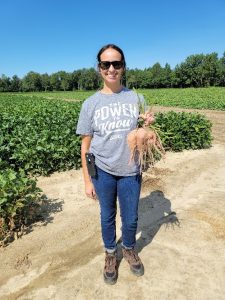Have you ever thought of a sweet potato as ugly? These tuberous, root vegetables are a holiday staple, but the sweet potato industry prefers a certain size, shape and weight for them to make it to your grocery store. Many farmers even leave the potatoes deemed “ugly” in the fields, because it costs more to harvest imperfect sweet potatoes than it does to leave them there to rot.
The consequences, including food waste, food equity and hunger, intrigued SAS graduate intern Shelly Hunt into thinking, “How could analytics help those farmers – and the ugly sweet potatoes?”
Hunt comes from a family tied to farming, so she has an awareness of food waste and the importance of local farming to help feed local communities. She grew up riding horses, and her father was raised in rural Ohio on a small farm.
“My curiosity and my passion for science are thanks to my father, who had such a brilliant and inquisitive mind. I know he would be so proud of me if he was still here,” she said.
Reducing food waste with predictive modeling
To support solving the sweet potato problem, Hunt uses predictive modeling. Her research focuses on helping farmers forecast and makes decisions ahead of time before the sweet potatoes are even planted. Looking at variables like weather trends and soil characteristics, farmers can adjust management decisions like fertilizer application rates or planting dates to affect certain vegetable features. These changes not only increase food yield but can also produce sweet potatoes that will be valuable.

“The heart of my research is understanding what leads to ugly produce, which in turn leads to food waste,” she said.
Hunt collaborates virtually with other students on her research using the cloud-based SAS® Viya® environment and multiple SAS products, including SAS® Intelligent Decisioning, SAS Visual Analytics and SAS® Model Studio.
Asking the right questions
“There is no single answer that will solve any of the world’s problems, so it takes a collection of diverse individuals with unique experiences and viewpoints to ask the right questions. Once we have those questions, we can start the research process that drives innovation,” said Hunt.
Initially, her research team at North Carolina State University used SAS® Model Studio to identify which physical shapes and characteristics of sweet potatoes are most important in determining sweet potato grade, a label given to the vegetable to evaluate overall quality.
Now, Hunt is aggregating weather, tillage, fertilization, pesticide and irrigation data in statistical and machine learning models to understand which variables drive variation in these shape features. She is also using visual analytics to create attractive and interactive reports that help producers understand their data. The research team is working with farmers to give them a tool they can use to make data-driven decisions that will increase their yield of marketable sweet potatoes, leaving fewer misshapen roots to go to waste.
There is no single answer that will solve any of the world’s problems, so it takes a collection of diverse individuals with unique experiences and viewpoints to ask the right questions.
Shelly Hunt, SAS graduate intern
Making a positive change
“My curiosity stems from my tendency to ask questions and eagerness to solve problems. All that I do—research, graduate studies, engagement with the agricultural industry—is because I know I have the capability to make a positive change for consumers and farmers alike,” she said.
According to Feeding America, 42 million people could experience food insecurity throughout this year alone. By increasing not just the amount of sweet potatoes grown, but the amount that makes it to your table, SAS is working to fight food waste and contribute to ending food insecurity.

9 Comments
This is a great story - thanks for writing/sharing it! (PS: I love sweet potatoes, even the ugly ones!)
Great story!
Awesome story. Thanks for sharing Shelly. I stuck a rooting spud into a pot and i beautiful leaves resulted - not sure what is under there but the leaves are gorgeous and apparently delicious.
Thank you for a sharing your great story.
Intriguing to learn how analytics is used - so cool - thank you
thanks for sharing your story! You are doing great things for agriculture!
Thanks for making the world a better place by reducing food waste! Is any sweet potato really ugly? I don't think so.
Agreed! Thanks for reading!
This is a great, relevant story. I look forward to hearing the progress she & the farmers will make by incorporating that additional data to help improve crop yields.